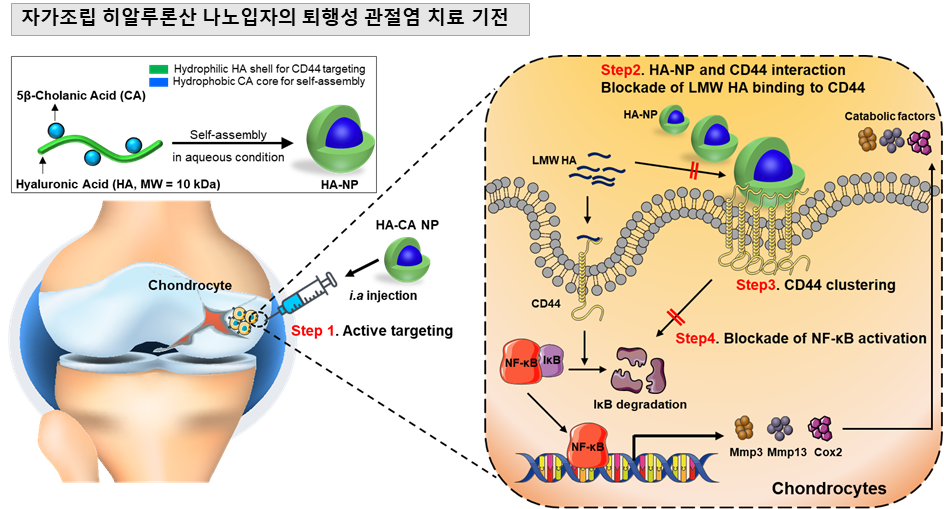- About Ajou
- Admission
- Academics
- Research
-
International
International
- Campus Life
-
News and Event
News and Event
-
AUT
AUT
Ajou News
NEW Kim Wook and Yang Si-young’s Team Confirms Self-Assembled Hyaluronic Acid Nanoparticles for Osteoarthritis Treatment
- 2021-08-03
- 5456

Professors Kim Wook and Yang Si-young’s team confirmed the osteoarthritis treatment mechanism of globular-shaped self-assembled hyaluronic acid nanoparticles. The recent finding is expected to contribute to improving in vivo safety and efficacy of linear hyaluronic acids used in chondroprotective agents for osteoarthritis.
Professor Kim Wook (Department of Applied Chemistry & Biological Engineering, left in photo) and professor Yang Si-young (School of Medicine, right in photo) of Ajou University announced that the team has confirmed the chondroprotective efficacy of globular-shaped self-assembled hyaluronic acid nanoparticles and inflammation relief action. This means that target-specific drug carriers can become a potential therapeutic agent for osteoarthritis treatment.
The study has been published in Biomaterials (IF 10.317), an international journal exploring the science of biomaterials and their translation towards clinical use, on June 19th with the title, “Self-Assembled Hyaluronic Acid Nanoparticles for Osteoarthritis Treatment.”
The number of osteoarthritis patients continues to rise globally as lifespans have continued to lengthen, bringing to population aging. However, injection-type high-molecular-weight hyaluronic acids currently used in drugs and chondroprotective agents are not stable within a living body.
The research team focused on self-assembled hyaluronic acid nanoparticles which are mainly used as in-vivo friendly, non-toxic, target-specific and long-acting drug carriers. As compressed globular-shaped self-assembled hyaluronic acid nanoparticles are relatively safer in vivo than linear hyaluronic acids, the team assumed that they are long-standing and provide increased inflammation relief.
Accordingly, the team injected self-assembled hyaluronic acid nanoparticles into the knee joint of mouse models and observed through a multiphoton confocal microscope that the nanoparticles that penetrated the cartilage cell membrane conjugated with CD44 receptors and protected joint cartilage against osteoarthritis progression.
This is evidence that multiple CD44-binding sites of nanoparticles conjugate with multiple CD44s at the same time, creating CD44 clustering in the cell membrane which effectively inhibits CD44 expression. The research team further explained that the drug carrier—self-assembled hyaluronic acid nanoparticles—itself, without any drug load inside, can inhibit CD44 receptors which aggravate joint cartilage erosion.
In addition, the team reaffirmed that CD44 receptors can be a target for developing osteoarthritis treatments.
CD44-deficient mouse models showed significantly lower osteoarthritis development compared to the control group with CD44 expression even when artificially inducing osteoarthritis in knee joints.
The latest study suggests potential use of self-assembled hyaluronic acid nanoparticles as osteoarthritis treatments that interact with CD44. This recent finding is very meaningful as it provides a clue to overcoming the limitations of current linear hyaluronic acids and their low stability and inflammation-inducing effects due to product degradations.
The study was sponsored by the Ministry of Science and ICT and the National Research Foundation of Korea as part of their Middle-grade Research Program and Bio/Medical Technology Development Program.

<Self-Assembled Hyaluronic Acid Nanoparticles for Osteoarthritis Treatment Mechanism>
